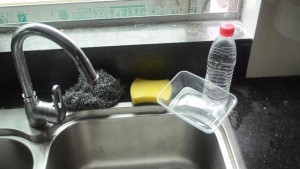When it comes to plastic products, many people are no strangers. In order to save time and convenience, many people like to put the plastic packaging box directly into the microwave oven for heating, and some people don’t want to throw away the plastic bottle, so they use it for cooking oil…
If you use plastic products improperly, you may be chronically “poisoning” yourself! What are the common misunderstandings of plastic products?
The habit of using these 3 kinds of plastics
May be chronically “poisoning” yourself
1. Use plastic bottles for cooking oil
Plastic bottles for mineral water, juices, carbonated drinks, usually have a “1” written on the bottom.
Plastic No. 1, which is polyethylene terephthalate (PET). This material has poor heat resistance, and the maximum operating temperature does not exceed 70 ° C. It is easy to deform when heated or filled with boiling water, and it will also dissolve harmful substances.
There is a clear study showing that the migration of phthalates (a type of plasticizer) in PET plastic bottles at the same temperature is nearly 20 times greater than that of water. Therefore, it is recommended to throw away the finished beverage bottle!
2. Put the packed plastic lunch box into the microwave to heat
The standards of plastic lunch boxes are 1 (PET), 5 (PP), and 6 (PS). The heat resistance of PET is only 70 °C, the heat resistance of PS is only 90 °C, and the heat resistance of PP material is 130 °C. ℃, the melting point is as high as 200℃. Therefore, generally only plastic No. 5 PP material can be put into the microwave oven for heating.
For reasons such as cost control, disposable lunch boxes usually do not have very high safety standards. The purpose of making them is to contain high-temperature, possibly oily food once, and it is safe to use under these conditions.
However, if it is used for many times, its stability will be destroyed, and the harmful substances in it will be precipitated, which may affect health in the long run. Therefore, although some disposable lunch boxes can be heated in a microwave oven, repeated use is not recommended.
3. Wash plastic lunch boxes/preservation boxes with steel balls
Brushing plastic with steel wire can damage the integrity of the plastic (such as scratches, etc.), thereby increasing the possibility of low molecular compound migration. Therefore, it is recommended to use a soft cloth for cleaning, so that the plastic lunch box may not be damaged too much.
02Do plasticizers cause cancer?
The Cancer Research Center under the World Health Organization classifies “DEHP” as a 2B carcinogen.
Although the plasticizer represented by DEHP may indeed migrate from some plastic products to food and finally enter the human body under certain conditions, the use of DEHP in food packaging is strictly limited, and its migration The dose will not reach the dose that will cause harm to the human body, and there is insufficient evidence of its carcinogenicity to the human body.
Therefore, “plasticizer carcinogenicity” still needs to be viewed scientifically.
03How to use plastic products safely?
General plastic products will use a number from 1-7 to indicate “identity”. These numbers include some safety tips:
Plastic No. 1:
Commonly used in the production of mineral water bottles, carbonated beverage bottles.
Note: do not hold hot water, and do not reuse.
Plastic No. 2:
It is mostly used to make containers for cleaning supplies and bath products.
Note: High density, strong and reusable.
Plastic No. 3:
Commonly used in the production of raincoats, garbage bags, plastic greenhouses, rubber pipes, etc. for agriculture.
Note: good performance, wear-resistant, acid-resistant, but not heat-resistant, toxic.
Plastic No. 4:
Commonly used in the production of cling film, plastic film and other materials.
Note: Breathable and impermeable, not heat-resistant.
Plastic No. 5:
Commonly used to make plastic cups and plastic lunch boxes.
Note: Can be used for food storage, microwave heating.
Plastic No. 6:
Commonly used in the production of bowls of instant noodle boxes and fast food boxes.
Note: Heat-resistant (heat-resistant 60℃~70℃) and cold-resistant, but cannot be placed in a microwave oven, and cannot be used for strong acid and strong alkaline substances.
Plastic No. 7:
It is mostly used to make milk bottles, space cups, etc.
Note: It is not advisable to install boiling water.
When using plastic products, you should carefully read the label or instruction manual of the product packaging, such as the applicable temperature of the plastic product, and whether it can be placed in a microwave oven or refrigerator.
It is recommended to reduce the use of plastic products, and more recommended to use cloth bags, paper bags, porcelain or glass products, which can not only protect the environment but also benefit your health!
Author|Yu Huanling, Professor, Department of Nutrition and Food Hygiene, School of Public Health, Capital Medical University
Health Guide
1. It is best not to use plastic bottles for cooking oil
2. Generally, only plastic No. 5 PP material can be put into the microwave oven for heating
3. Do not wash plastic lunch boxes / crisper boxes with steel balls
4. “Plasticizer carcinogenicity” still needs to be looked at scientifically
